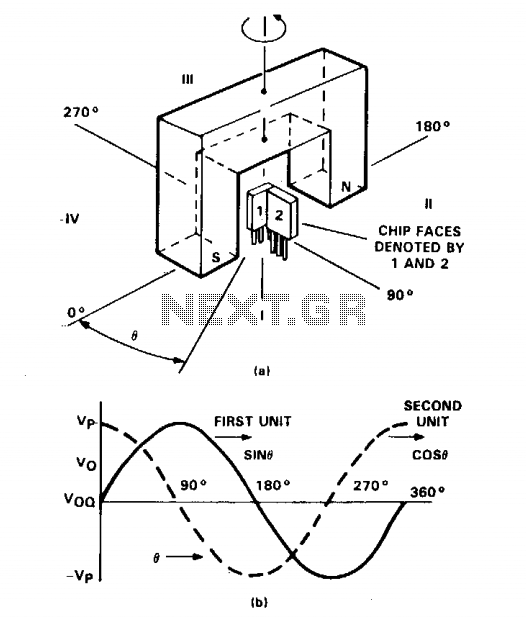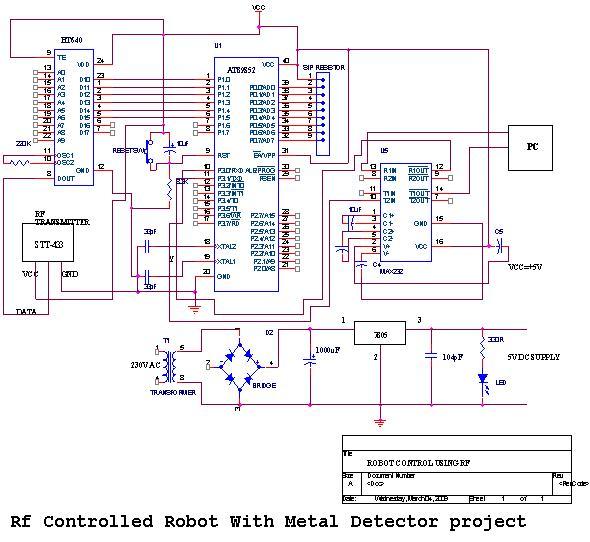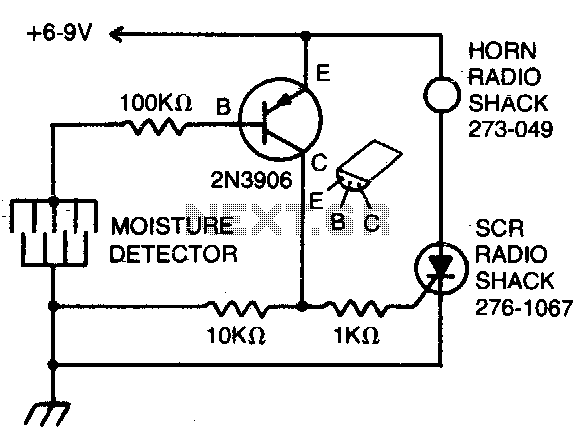
Angle of rotation detector

The figure illustrates two TL3103 linear Hall-effect devices utilized for detecting the angle of rotation. The TL3103 devices are positioned in the gap of a U-shaped permanent magnet. The angle formed between the south pole and the chip face of unit #1 is designated as angle 0. This angle is defined as 0° when the chip face of unit #1 is perpendicular to the south pole of the magnet. As the south pole of the magnet moves through an angle range of 0° to 90°, the output of the sensor increases from 0°.
Additionally, sensor unit #2 decreases from its maximum output of +Vp at 0° to a minimum value of Vqq at 90°. Therefore, the output of sensor unit #1 represents a sine function of angle 0, while the output of unit #2 corresponds to a cosine function of angle 0, as depicted. Consequently, the first sensor provides the angle of rotation, while the second sensor indicates the quadrant location.
The circuit employs two TL3103 linear Hall-effect sensors, which are sensitive to the magnetic field generated by the U-shaped permanent magnet. The configuration of the sensors allows for precise angular measurement. The output from unit #1, which follows a sine function, effectively translates the rotation angle into a voltage signal that varies sinusoidally as the angle changes. This characteristic is particularly useful for applications requiring accurate angle detection.
Conversely, sensor unit #2, exhibiting a cosine function output, serves to determine the quadrant in which the rotational movement occurs. The maximum output of unit #2 at 0° signifies that the sensor is aligned with the magnetic south pole, while the gradual decrease to Vqq at 90° indicates a transition through the quadrants.
This dual-sensor arrangement is advantageous for applications such as robotics, automotive steering systems, and other precision control systems where both the angle of rotation and quadrant positioning are critical for functionality. The integration of these sensors into a control system can enhance the accuracy and responsiveness of the overall system, facilitating improved performance in real-time applications.The figure shows two TL3103 linear Hall-effect devices used for detecting the angle of rotation. The TL3103s are centered in the gap of a U-shaped permanent magnet. The angle that the south pole makes with the chip face of unit #1 is defined as angle 0. Angle 0 is set to 0° when the chip face of unit #1 is perpendicular to the south pole of the magnet. As the south pole of the magnet sweeps through a 0° to 90° angle, the output of the sensor increases from 0°.
Sensor unit #2 decreases from its peak value of + Vp at 0° to a value Vqq at 90°. So, the output of sensor unit #1 is a sine function of 0 and the output of unit #2 is a cosine function of 0 as shown. Thus, the first sensor yields the angle of rotation and the second sensor indicates the quadrant location.
🔗 External reference
Additionally, sensor unit #2 decreases from its maximum output of +Vp at 0° to a minimum value of Vqq at 90°. Therefore, the output of sensor unit #1 represents a sine function of angle 0, while the output of unit #2 corresponds to a cosine function of angle 0, as depicted. Consequently, the first sensor provides the angle of rotation, while the second sensor indicates the quadrant location.
The circuit employs two TL3103 linear Hall-effect sensors, which are sensitive to the magnetic field generated by the U-shaped permanent magnet. The configuration of the sensors allows for precise angular measurement. The output from unit #1, which follows a sine function, effectively translates the rotation angle into a voltage signal that varies sinusoidally as the angle changes. This characteristic is particularly useful for applications requiring accurate angle detection.
Conversely, sensor unit #2, exhibiting a cosine function output, serves to determine the quadrant in which the rotational movement occurs. The maximum output of unit #2 at 0° signifies that the sensor is aligned with the magnetic south pole, while the gradual decrease to Vqq at 90° indicates a transition through the quadrants.
This dual-sensor arrangement is advantageous for applications such as robotics, automotive steering systems, and other precision control systems where both the angle of rotation and quadrant positioning are critical for functionality. The integration of these sensors into a control system can enhance the accuracy and responsiveness of the overall system, facilitating improved performance in real-time applications.The figure shows two TL3103 linear Hall-effect devices used for detecting the angle of rotation. The TL3103s are centered in the gap of a U-shaped permanent magnet. The angle that the south pole makes with the chip face of unit #1 is defined as angle 0. Angle 0 is set to 0° when the chip face of unit #1 is perpendicular to the south pole of the magnet. As the south pole of the magnet sweeps through a 0° to 90° angle, the output of the sensor increases from 0°.
Sensor unit #2 decreases from its peak value of + Vp at 0° to a value Vqq at 90°. So, the output of sensor unit #1 is a sine function of 0 and the output of unit #2 is a cosine function of 0 as shown. Thus, the first sensor yields the angle of rotation and the second sensor indicates the quadrant location.
🔗 External reference
Warning: include(partials/cookie-banner.php): Failed to open stream: Permission denied in /var/www/html/nextgr/view-circuit.php on line 713
Warning: include(): Failed opening 'partials/cookie-banner.php' for inclusion (include_path='.:/usr/share/php') in /var/www/html/nextgr/view-circuit.php on line 713





